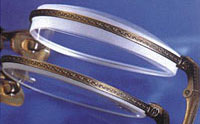High Index Lenses

High Index Plastic
A plastic material that is thinner, almost 1/3 less thinner than a normal plastic lens. It does not contain the impact resistant qualities of polycarbonate. High index plastic is available with the following indexes of refraction: 1.54, 1.55, 1.56, 1.6, and 1.66. These lenses are 8% to 25% lighter and thinner than CR-39 (normal plastic), depending on the prescription. The approximate weight is equal to polycarbonate, which is lighter than CR-39, depending on the prescription.Note - Comparison to Polycarbonate: Both materials have a high index of refraction and are lightweight. Both can be ground to thin profiles. However, high prescription patients may experience more chromatic aberration with Polycarbonate than with 1.6 High Index Plastic in the periphery of the lens. This is due to a higher Abbe value (standard measure of color dispersion) for 1.6 High Index Plastic (36 vs. 30), meaning it has less chromatism.

Advantages of High Index Lenses
High index lenses are thinner than the other lenses. Because of their ability to bend light more efficiently, High index lenses are able to bend light to a stronger degree than a lens with a lower index, high index lenses for nearsightedness offer thinner edges than lenses that are made of conventional plastic material with the same prescription power. High index lenses are 20 percent to 65 percent thinner than standard plastic lenses. In general, the stronger the prescription, the greater the difference in thickness between standard plastic and high index plastic. Therefore, High index eyeglass lenses are the right choice if you want thinner, lighter lenses and eyeglasses that are as attractive and comfortable as possible.High index lenses are lighter than the other lenses. Thinner edges require less lens material, which minimizes the overall weight of the lenses. Lenses made of high index plastic are lighter than the same lenses made in conventional plastic, so you will feel more comfortable when you wear high index lenses. Lightweight lenses are even more of a advantage for farsighted prescriptions, which could make conventional lenses very weighty. And most high index lenses also have an aspheric design, which gives them a slimmer, more attractive profile and reduces the increased “bug-eye” look that conventional lenses cause in strong farsighted prescriptions.
